If you would like to see real time garden updates and photos please be sure to follow me on instagram https://www.instagram.com/gardenintheburrow/
I try to post there daily and sometimes even remember to tell you where I will be speaking next 🙂
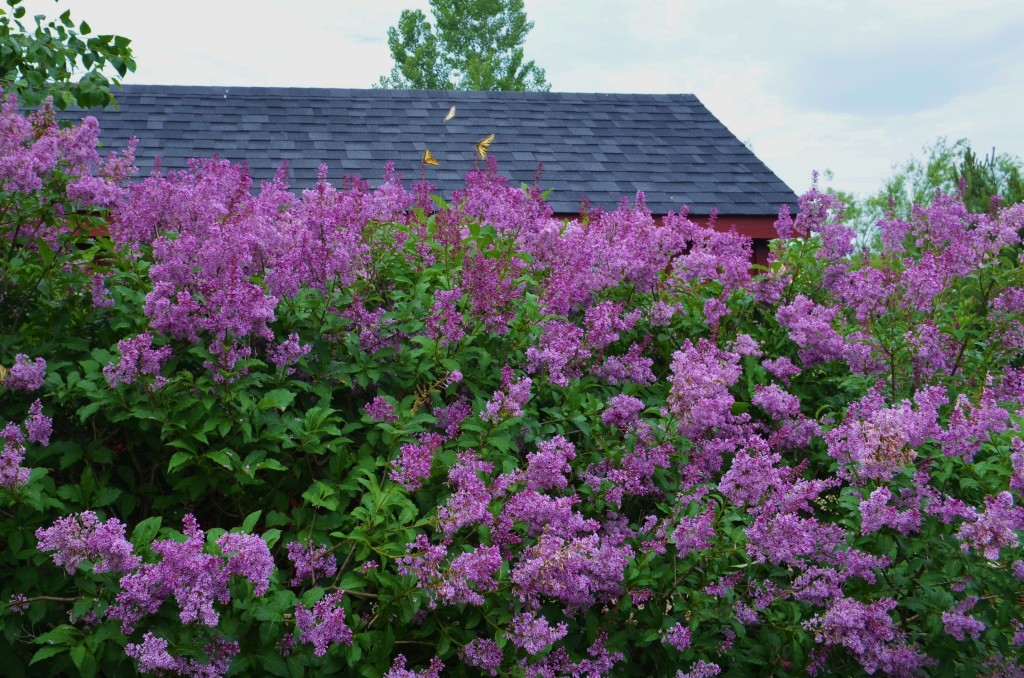
As I mentioned in my last post, one of the best things about growing clematis is how from year to year you can use them make the garden more dynamic and interesting. Unlike,for example a peony, or a hydrangea, a clematis vine is pliable and trainable. If you are willing (and home enough to tie them in as they grow as after they twine together it is too late) , you can do lots of fun things to change the garden up a bit without re-planting.
Here are a few more ideas to help you if you want to give them a go!
This clematis ‘Betty Corning’ is one I have planted a number of times here, It is a long bloomer and pretty much problem free. It can reach 12 ft easily so I usually train it up onto the porch, sometimes up the posts , sometimes times along the railings . The one on the back side of the house( seen below) I often train year after year on the railings as it blooms right next to a comfy couch and feels like an old friend joining me for morning coffee.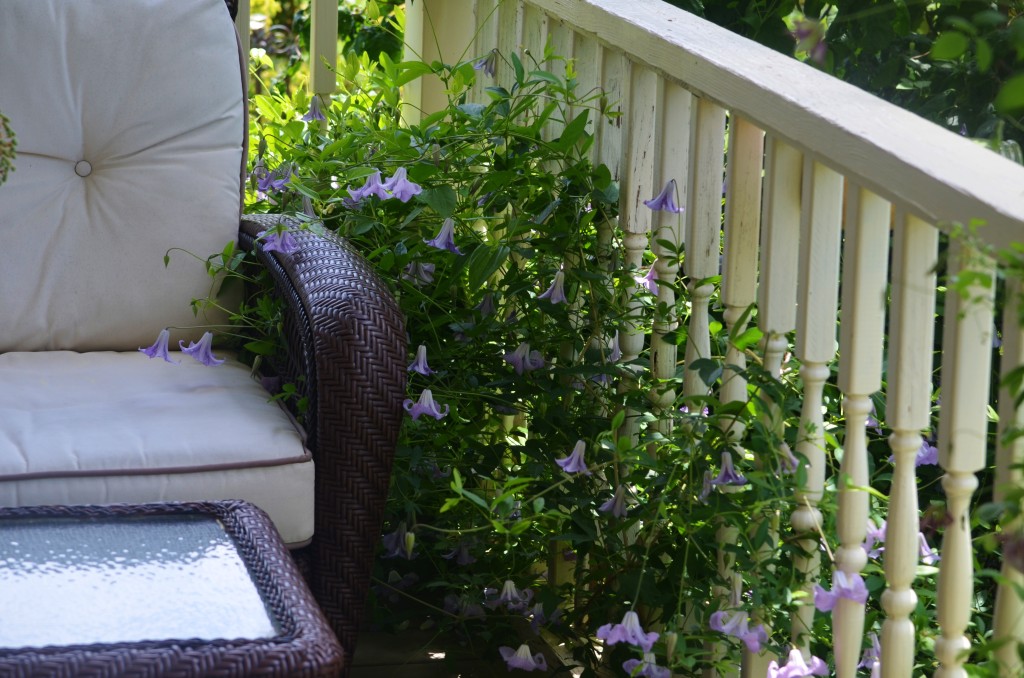
This spring , right behind Betty, , a beloved Harry Lauder’s Walking Stick up and died. It never looked sickly, just died what I call Daphne Death, sudden and without warning.
I can’t bear to part with it just yet so this year I trained good ole Betty into it and honestly Harry looks pretty fantastic as a trellis. I don’t know how many years I will get before it all breaks but whether it is this clematis or another vine, something will grown on Harry until he can take no more.
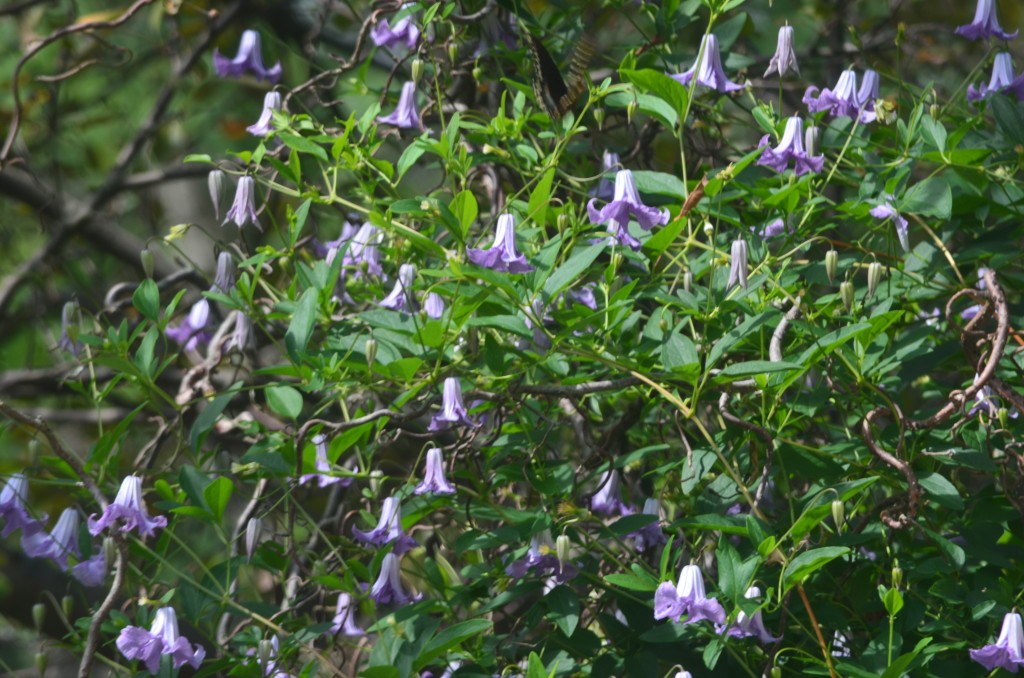
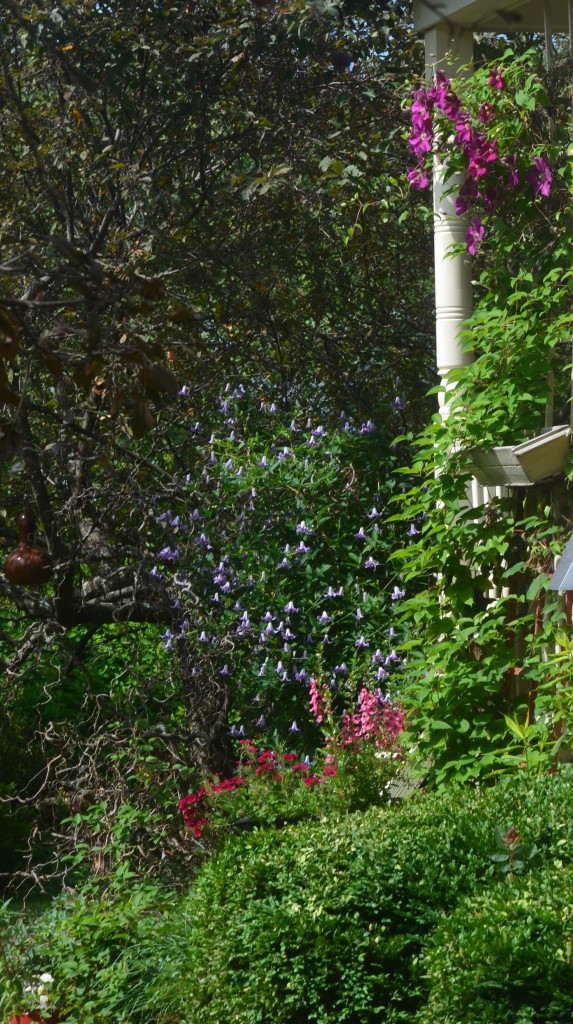
Out front is another clematis that is a tried and true long blooming variety called ‘Comtesse de Bouchard’ . (The color is a little purply in this photo , it is actually quite pink)
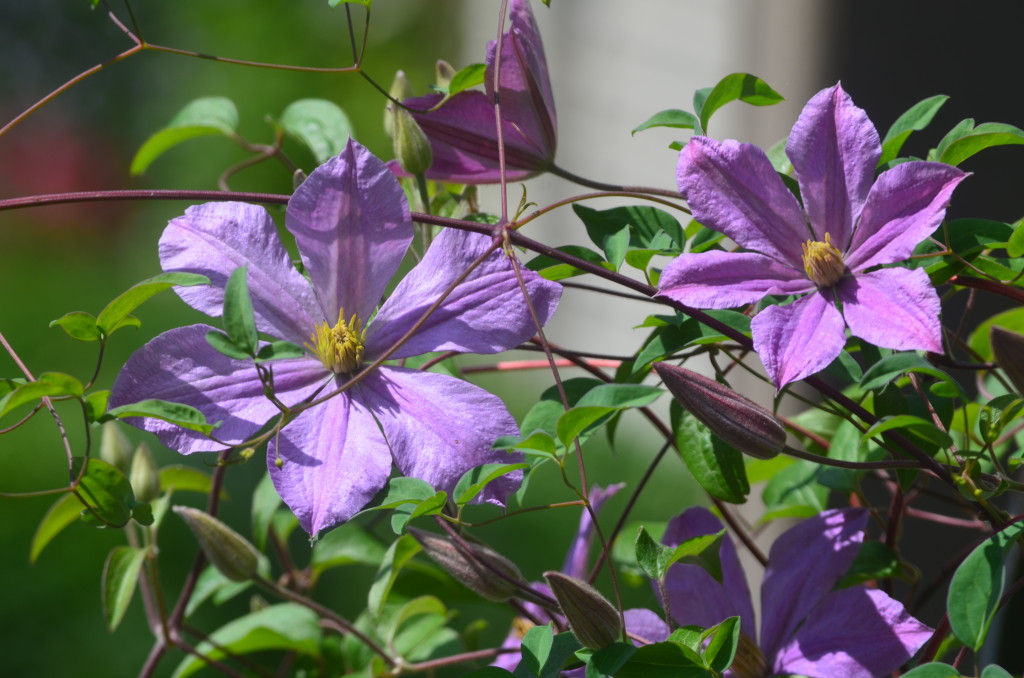 It sits next to a section of post and rail fence which is has been trained to cover in some years, while others I sub in another structure like this funky thing
It sits next to a section of post and rail fence which is has been trained to cover in some years, while others I sub in another structure like this funky thing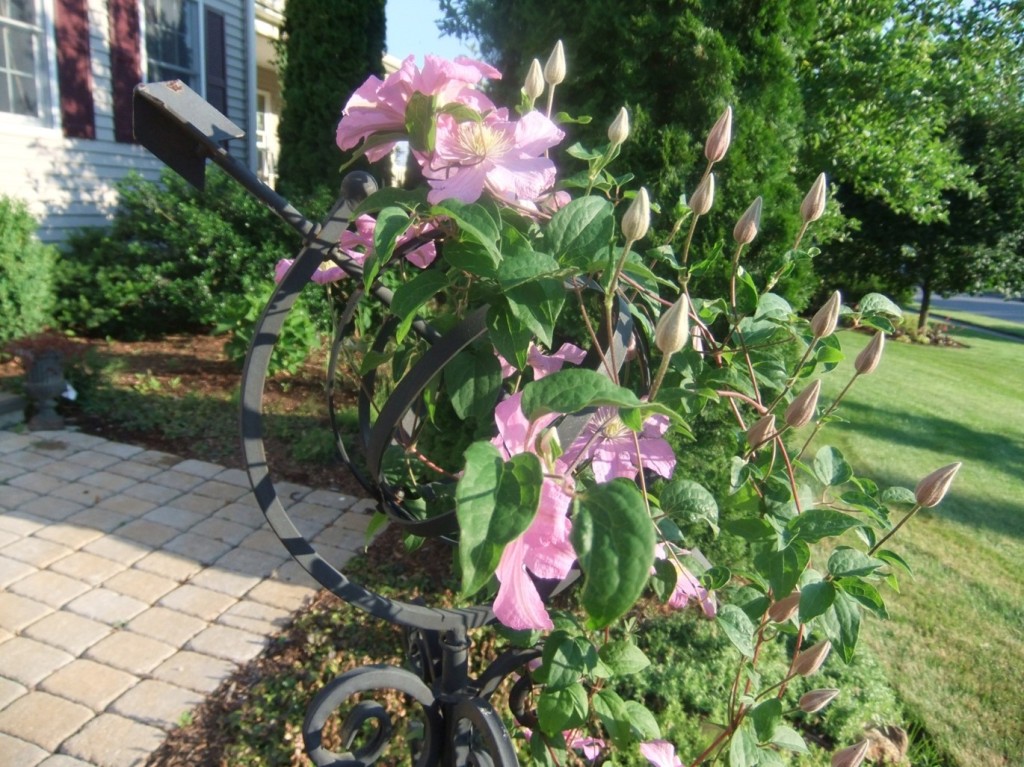
On the fence it grows more toward the front of the garden
On the vertical supports it stands out like pretty pink flag above the rest of the plantings. This year it is on yet another structure, sort of an iron tripod .
Last example for today is a newer variety for me called ‘Pink Mink’. I had it on green trellis for two years , training it near,but not into ,an adjacent birch tree, This year I am trying it into the tree sans trellis , and boy oh boy do I like the look. 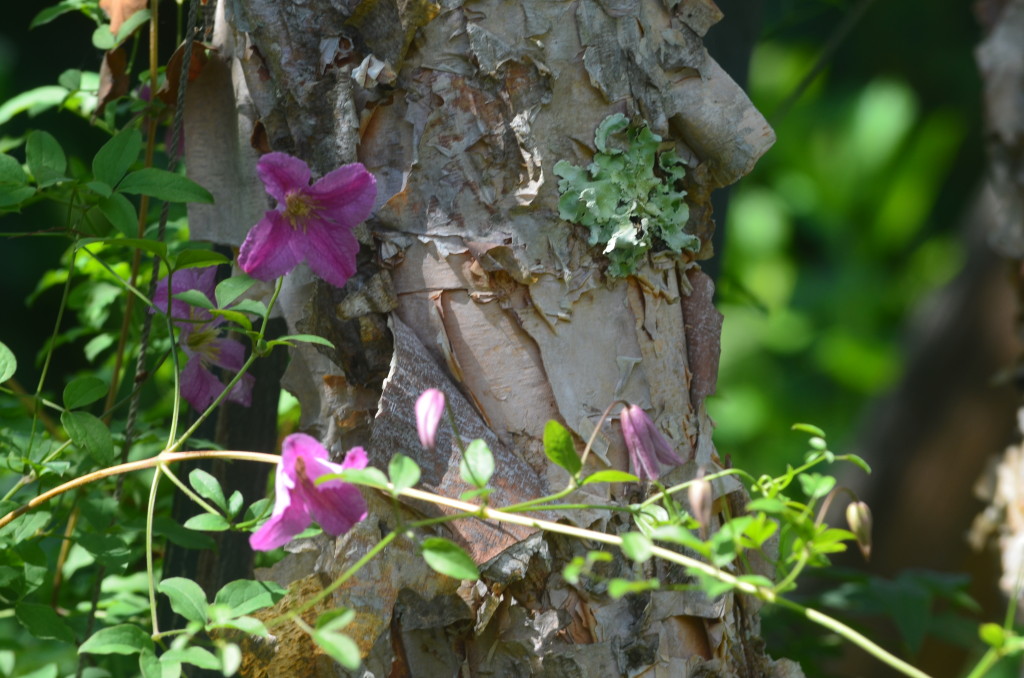
Exfoliating bark, lichen and clematis;one of the most winning combinations in the garden there ever was
Stay tuned for more …… with 130 of the darn things here , my options seem pretty limitless lol
If you have heard me speak on growing clematis you may remember my directions for growing that will bloom in tandem for an exciting and guest-gasp inducing display………Plant two that are from the same pruning group , ‘It’s that easy!” I say, and I stand by that.
Two group ones ( although holy hell that would need a large structure indeed) two group twos, or two group threes, all will work as garden partners , blooming happily together and requiring lots of photos to be taken of their beauty and to show off your garden prowess.
On the other hand there are ways to go about it that are indeed more difficult.
I have grown two varieties together that are of different pruning groups. One epic fail was Elsa Spaeth ( a 2) and Comtesse de Bouchard ( a 3) which meant cutting poor Elsa back every year until she had quite enough of the rough treatment and sulked mightily until I separated her from her growing mate and let her shine on her own.
I have broken my own rule frequently about how to grow them together , often to disastrous results, but let’s not visit the past ,heh?
This year I am trying three together that most certainly and under no circumstances should be grown together . Why not? If nothing else I will have a future failure to learn from and report.
The three victims, ahem, Growing partners, are
Elsa Spaeth (Spath ) who often gets subjected to my experiments),is a lovely group two pruned clematis that is just stunning in the garden with her fancy deep purple flowers with dark bars that fade to another purple altogether with the passage of time.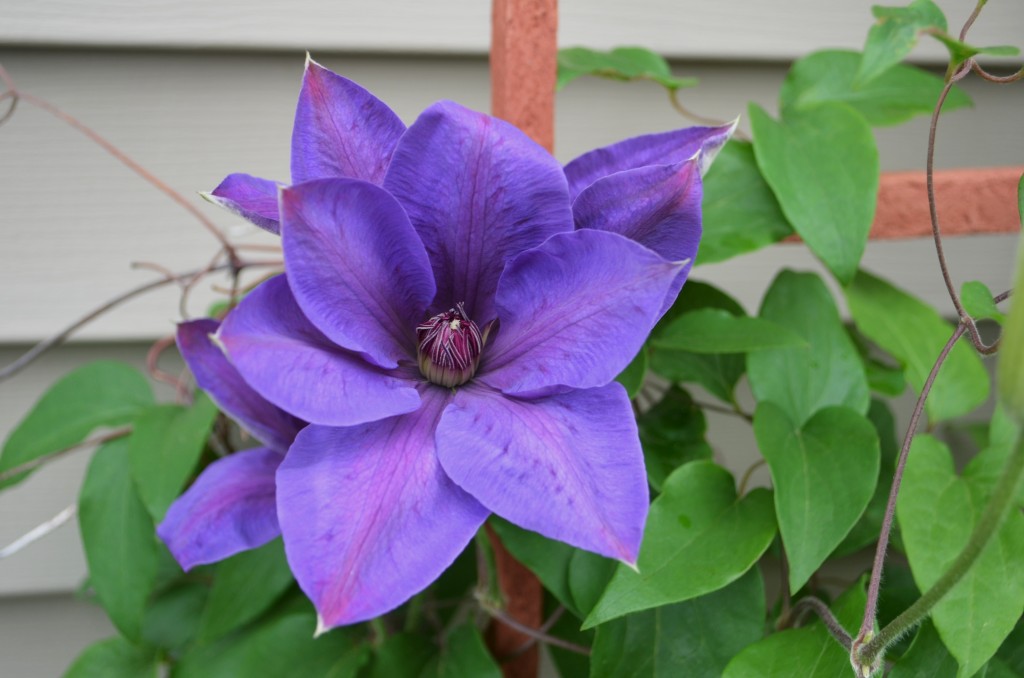
Clematis ‘Summer Snow’ , or c.’Snow in Summer , or or c. Paul Farges….this clematis is sold under many names and like many clematis has an interesting and convoluted nomenclature story ( you can read here) . Although I have seen it listed as a group 2 it is a group 3 , hard prune in spring for flowering on new growth. This is where the trickiness begins, Summer Snow is vigorous, and will grow to be about 20×20 feet in one summer. It starts to flower mid-June here which works for my plan, and it’s saving grace is that is leaves are spread out on long stems so although quite large it is not as smothering as many of the larger vines can be.
The last one is most definitely the oddest choice, and it is clematis crispa, or swamp leather flower. Those who know what the gardens are like here ( dry sand) may wonder if I have lost my marbles, and honestly it is a fair question. This species, unlike the majority of clematis species, likes wet soil. A few years ago I decided to try growing it here on a whim. I placed it under my main bird feeder which is located both near door I use most as well and hose reel. I will say it is not what it would be in a Georgia swamp, but it is growing nicely and has bloomed regularly.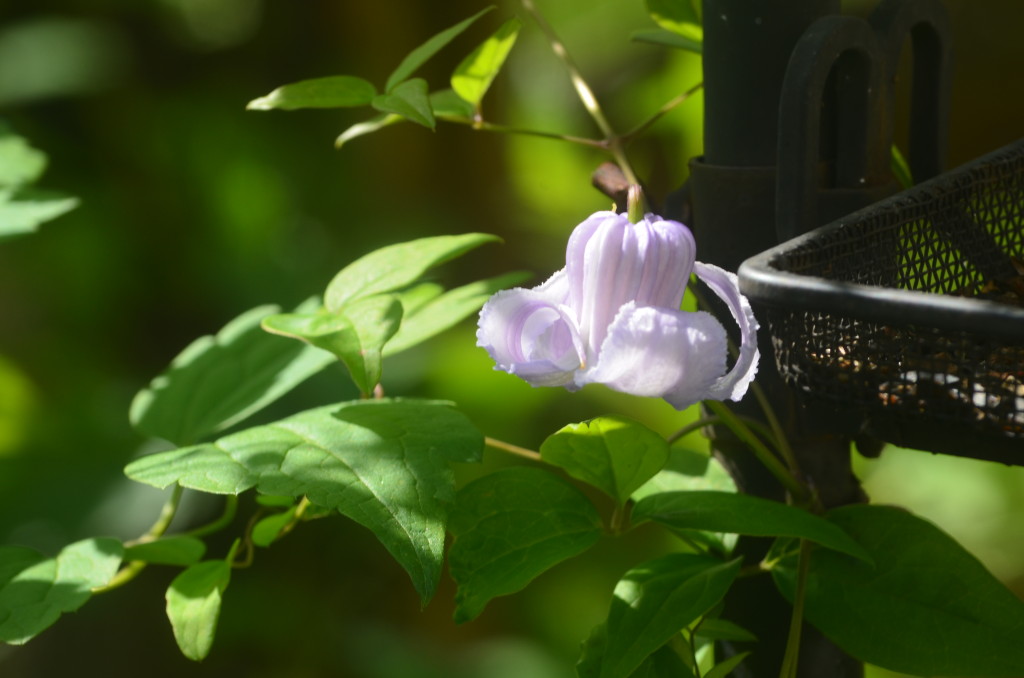
One of the surprising things I have found here, is that after they are settled in the garden for a few years ALL of my clematis are among the top most drought tolerant plants I grow, Rarely do they even show a hint of suffering . If they ever look ragged all it takes is a visit from the loppers and they grow back better than ever. This may be pushing it though.
My three very unlikely growing partners are planted a few feet from each other and then trained to grow toward each other using a small garden cart, the bird feeder pole and a section of fence to help keep them supported. One of the fun parts about growing clematis that you prune to the ground is that each year you can train them in a different direction, or up a new structure , or into a large shrub or tree. I have one this year that usually grows in the fence that was given a tall tripod to climb this year to change the look of it’s garden area, and another that usually grows into a variegated dogwood shrub that has been trained in a low arch over some landscape rose bushes. Really, the possibilities are endless if you use your imagination.If you don’t have any imagination, you have the interwebs , google, Pinterest and ME!
Back to the three. They are all just starting to bloom. I am happy with the result with an underlying sense of dread as I watch Summer Snow set it’s sights in covering the entire garden. Oh well. that is what pruners are for and I will remain on guard . You may also notice, and shake your head in bewilderment , that there is a large honeysuckle in the mix, We call that being a glutton for punishment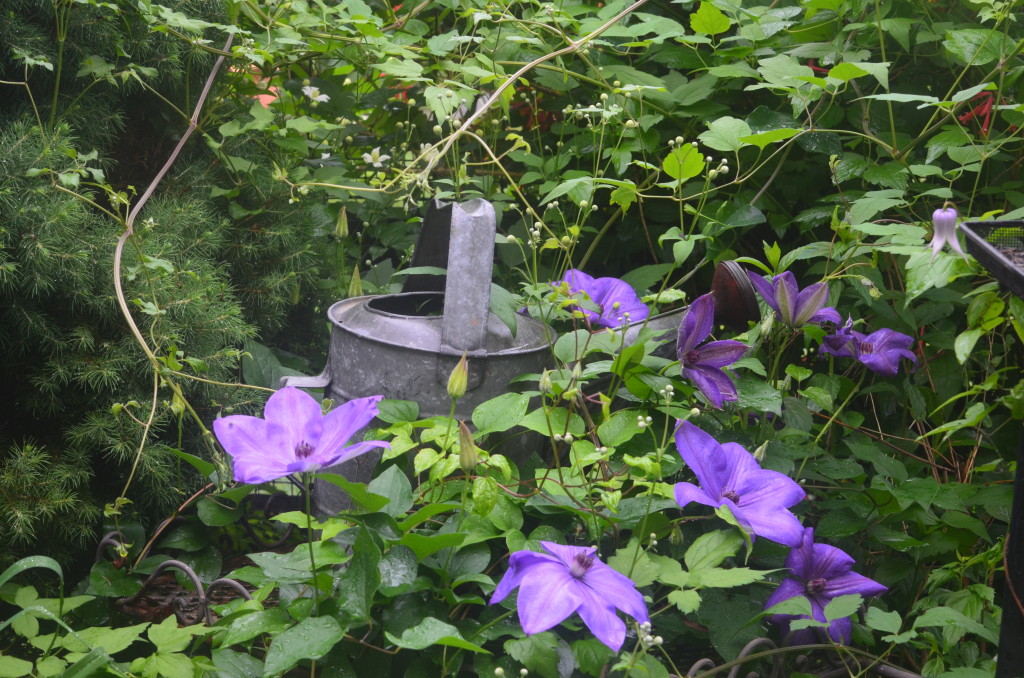
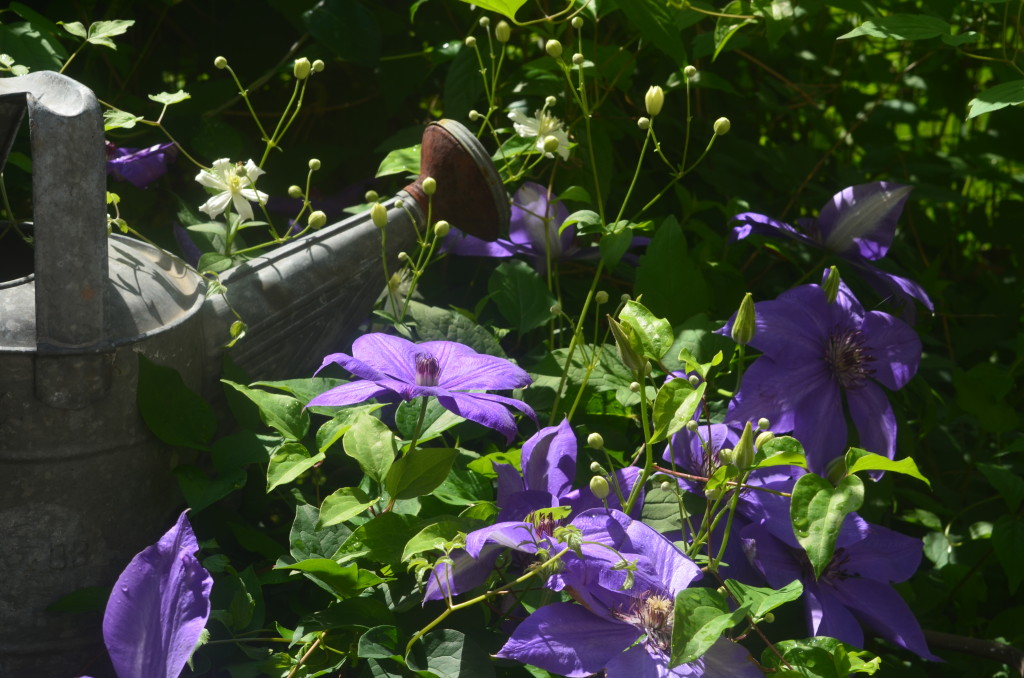
Gardeners I speak to are always on the lookout for easy to care plants that can fit a variety of garden situations: sun shade, wet or dry , attract pollinators, feed the birds, be drought resistant, require zero pruning and look good in the garden all the time. The demand list is long and very often plants that fit the bill are overlooked either due to showier nursery mates or the lack of a marketing team behind them. Lindera benzoin, or as it is commonly called, spicebush is one such plant.
The Spicebush is native to the Eastern US and has a lot to offer us as gardeners. It blooms in tiny clusters of acid yellow flowers in April before the leave emerge,much like the ubiquitous forsythia.
The stems and bark have a slight fragrance of spiciness/cinnamon when crushed or cut , hence the name , and this attribute makes almost 100 percent deer and rabbit proof. There are actually areas of deciduous forest south of us where the deer pressure is so high Spicebush is one of the few remaining residents of the forest floor . Deer just will not eat it.
In the late summer it is covered in bright red drupes that the birds love , and the berries are followed by a striking yellow fall foliage color as the weather cools .
As if that were not enough,it is the larval food source for the Spicebush Swallowtail . The eggs are deposited on the shrub and after noshing for a bit the caterpillars spin silk on the mid rib of the leaves that as it dries will curl the leaves around their bodies. In the summer you can walk up and uncurl them and peek inside to see their little bums that are adorned with makings to scare off predators, but look pretty comical to me .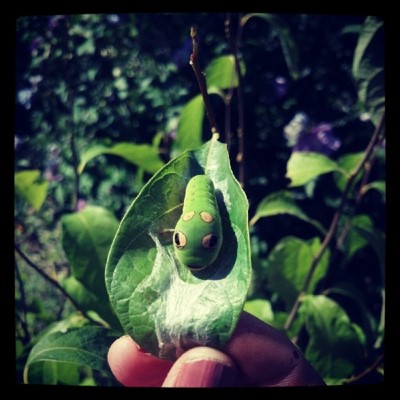
The adult butterflies have a long proboscis allowing them to feed at a variety of long tubular flowers in the summer. Here we always see them on the trumpets vines and in the daylillies.
This shrub can be planted in full sun to almost full shade but will flower and color up in fall best with sun. As an under-story plant with deciduous trees overhead you will get great flowering , but not so great fall leaf color. It is hardy in zones 4-9 and can tolerate wet or dry soil. It is a fantastic option for a deciduous hedge in areas with very high deer pressure and may work to enclose an area of more sensitive plants to keep them hidden from Bambi.
contact me at gardenintheburrow(at)hotmail(dot)com for more information and booking
Designing a great garden space takes time, thoughtfulness, and knowledge not only of plants but of the wishes person you are designing for . To carefully construct a space that feels natural, welcoming, both relaxing and exciting at the time time, can be tricky business indeed. Those of you who have heard my design presentations know how much goes into each little space I design ;seasonal planting succession, fragrance, color, height variations, privacy screens, , this list of considerations goes on and on.
So for a few weeks I am going to show you some of the seating areas here and how the design was planned and has evolved .
Wil and I appreciate things in very different ways. without getting into a long dissertation on how we view the world and who is right, I will tell you that he judges a garden by it’s seats. Every garden, every tour, he sits in every seat and assess the view. They get a thumbs up or a thumbs down, and sometimes some added slurs depending on how bad it is and you would be very surprised at the people whose gardens he is dissapointed in solely based on how poorly they placed their seating. Being a non-gardener he is not ever judging the rarity or quality of the planting, just what he can see from each and every chair,chaise or settee placed within.
Therefore, many of my garden spaces are designed with views from chairs in mind. The other gardeners we visit are lucky in that he never shares his opinions with them, but with me he is , shall we say, pretty vocal, so there is pressure to get it right.
Today’s featured seats are two of my favorite. When we added on an addition to the house we were lucky enough to be able to include a porch off the side. I wanted a very wide staircase ( for photo-ops of course) and room for some seating. Although it is far from large it is perfect for morning coffee and afternoon naps. ( FYI the rug was one f the BEST finds from a thrift store nearby for $25)
From here you look out onto a long curved shrub border peppered with both evergreen and deciduous trees including my favorite evergreen, the concolor fir.
A crab apple tree (Mrs. Robinson’) is very close to the railings on one side to keep birds nearby 
and several clematis wind their way up and into both the shrubs and the porch railings.
Some even want to sit with you
A very large clematis terniflora used to provide shade and privacy .It was planted along with a few otherclematis vines but for some reason the area out front has proven difficult to keep them going so now a very large and sprawling akebia vine is filling the purpose
The most important thing for me when picking plants for this area was fragrance. Starting in the earliest part of the year we have viburnum carlessii planted very close as it’s fragrance will not carry in the cold air of April when it blooms .
Soon after it fades , the calycanthus florida takes over . It s placed pretty far into the shrub border as it can be cloyingly sweet and very strong in the strengthening sun of late May and June. It smells like a pina colada and drifts up to the porch quite easily
Quickly after that the New Dawn rose begins to bloom

Cue the heavenly scent of the summersweet .Both Clethra alnifolia ‘Ruby Spice’ and ‘Alba’ perfume the entire area for the late part of the summer.
Fall color form the viburnum, the summersweet, and the other shrubs in the border, late blooming hydrangea paniculata ‘Limelight’ with it’s fading mauve flowers,the colorful bracts of the Seven Son’s Flower and viburnum berries and crab apples are the interest to both me and the birds and bees going right through the rest of the gardening season.
An old church pew adorns the area aside the door where i place little arrangements of things cut from the garden
There are usually a few containers on the stairs or on the porch itself including this bouganvilla that loves it’s spot at the top of the stairs where it gets indirect sunlight all day .
these guys like it a lot too (photo from 2014)

Tonight at the Lynnfield House , Main Street, Lynnfield, MA 7:30 pm
Meeting open to the public
Grow it! Cut it! Arrange it!: Want to have beautiful blooms fresh from your own garden to adorn your house and table but don’t have the space for a separate cutting garden? This program will give you plant selections you can easily work in to your existing garden space that will provide you bouquet after bountiful bouquet as well as suggestions for foliage , fruit and other fun additions to make your arrangements POP!